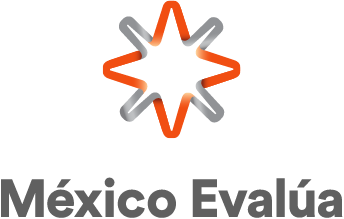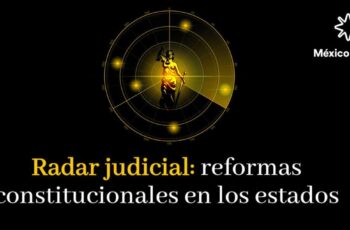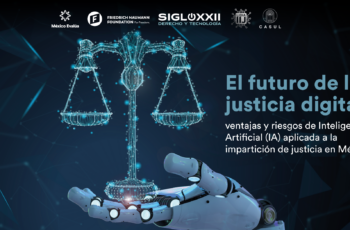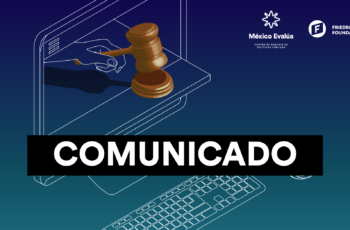Digital justice in Mexico: the balance one year after the start of the pandemic
By Laurence Pantin (@lpantin) and Sandra Escamilla (@sandritaeceron) | Animal Político
One year after the start of the covid-19 pandemic, we are still unable to do things the way we used to. It is not surprising, then, that this pandemic has also caused a paradigm shift in the administration of justice.
In Mexico, most of the judicial powers have had to close or restrict their attention to the public in person for several months, which has forced them to look for alternatives to continue offering their services, among which is the digitalization of part of them. This transformation process has been very uneven, because while some began to develop technological solutions and tools for a long time, others had to hurry to implement them.
In this context, the lack of regulations, particularly in civil and family matters, is one of the main limitations that the judiciary has had to face. The delay by the Congress of the Union in issuing the National Code of Civil and Family Procedures has caused a bottleneck, because if it is not approved, the entities do not have authorization to reform their local codes. Consequently, any digital tool implemented regarding these matters could be challenged.
Another obstacle has been the unavoidable budget issue, which many judiciaries have overcome with the help of creativity and innovation. They have been imagining various low-cost solutions that, although they do not imply the use of state-of-the-art technology, have helped them to reactivate their services. For example, some of them have implemented mail or telephone appointment systems so that people can physically submit their lawsuits or promotions.
A wave that doesn’t stop
These advances, although gradual, have been transforming the way in which the judicial powers work. For example, in April 2020 we identified 13 judicial powers that had an electronic file; today there are 23 and one that is developing it. On the other hand, at the beginning of 2020 we only found five judicial powers that had a platform that offered the possibility of filing lawsuits or promotions remotely and one that was developing one. To date, 14 judicial powers have this tool, two are developing it and another two have enabled emails to receive lawsuits and promotions, as shown in the following graph.


Regarding the possibility of offering the online electronic signature process —a fundamental tool to verify the identity of people who initiate legal proceedings online—, in October 2020 only seven judicial powers offered it, and today there are 10.
These advances show that judicial powers are capable of adapting and changing, but can the same be said of users? How and to what extent have these tools been used and how useful are they in practice? Although these questions should be at the center of the discussion on the subject of digital justice, there is not much information about it yet.
The statistics of the judicial powers themselves can give us an indication. For example, the Judicial Branch of Nuevo León, one of the pioneering judicial powers in the implementation of this type of tool, received a total of 12,936 lawsuits in 2019 through some digital tool (which represented 7.7% of the total lawsuits received). For 2020, these totaled 33,660, an increase of 160% compared to 2019 and 10.8% compared to the total of lawsuits received that year. In 2019, 24% of the total of promotions were submitted online, a proportion that increased to 57% in 2020. Finally, in 2020, 17,903 trials were carried out entirely online, while in 2019 none were carried out. This figure is also on the rise, since only so far in 2021, 7,281 trials have already been carried out online.
This scenario is similar in other judicial powers. For example, in Querétaro, no promotion was presented by digital means in 2019, but last year 23,870 promotions were presented through the electronic file or by email. For its part, in the State of Mexico last year, 33,981 lawsuits and 124,621 promotions were filed through some digital tool, and 28,085 remote hearings were held.
These data show that, at least in some judicial powers, online procedures are becoming more common every day and have gradually managed to establish themselves as a feasible option for conflict resolution. In this regard, the case of Chile draws attention, where, in response to the contingency and the growing number of hearings that were held by videoconference, the Feasibility Hearing was created. Its objective was to offer a space where users involved in a trial —judicial officials, lawyers, etc.— could state the reasons why a trial could or could not be held online. However, this hearing has been falling into disuse, because most of the processes are now carried out online without objection from the parties[1]. Another indication comes to us from the Judicial Branch of Querétaro. There, according to the president of the Superior Court of Justice of the state, both lawyers and officials have been getting used to the use of these tools, which has made it possible to overcome internal and external resistance.[2]
Although the judicial powers in Mexico still have a long way to go in terms of digital justice, there are examples in Latin America of judicial powers that today are a benchmark and can give us an idea of what to expect in the not-so-distant future. The work of Juan Gustavo Corvalán, director of the Innovation and Artificial Intelligence Laboratory of the University of Buenos Aires, is noteworthy. He has helped various governments to streamline and transform the way in which they administer justice through systems that use artificial intelligence. One of these tools is Pretoria, an intelligent system of the Supreme Court of Justice of Colombia that, through the machine learning technique, allows us to detect patterns in thousands of sentences and make a
report of each one of them in a matter of seconds, with the purpose of detecting cases in which the person has some situation of vulnerability —such as some health affectation, for example—. This allows them to be prioritized and thus improve decision-making by officials. This system also makes it possible to automate responses to lawsuits filed with the Judiciary, reducing the time needed to process them hours or even days.
According to Corvalán, these tools have great advantages. By identifying the opportunities for systematization and prediction, they allow to debureaucratize judicial processes, optimize processes and maximize the knowledge base on which cases are decided. In other words, these technologies are not designed to displace or replace judicial officials, as is commonly thought, but rather to complement and maximize their response capacity. Bureaucratic tasks are carried out by these intelligent systems, leaving more time for officials to attend to more important aspects, which increases the quality of the judicial response.
All these and other good ideas and trends can be found on our digital justice microsite and in the Guide of good practices in the use of new technologies for the administration of justice that we published last year. The aim is to glimpse the potential of these tools to transform the administration of justice and expand access to it. It is time to see them with different eyes, that is, stop considering them as a threat.
Indeed, this vision invites us to rethink the way in which we imagine the future of digital justice: perhaps we will not have a robot judge in the literal sense of the word, but we will have intelligent systems that help judges to free themselves from the heavy administrative and bureaucratic burden focusing their time on aspects that can make a difference on the path towards a more humane justice.
[1] Personal communication with Mauricio Olave, president of the National Association of Magistrates of Chile.
[2] Personal communication with the presiding magistrate of the Superior Court of Justice of Querétaro, José Antonio Ortega Cerbón.









